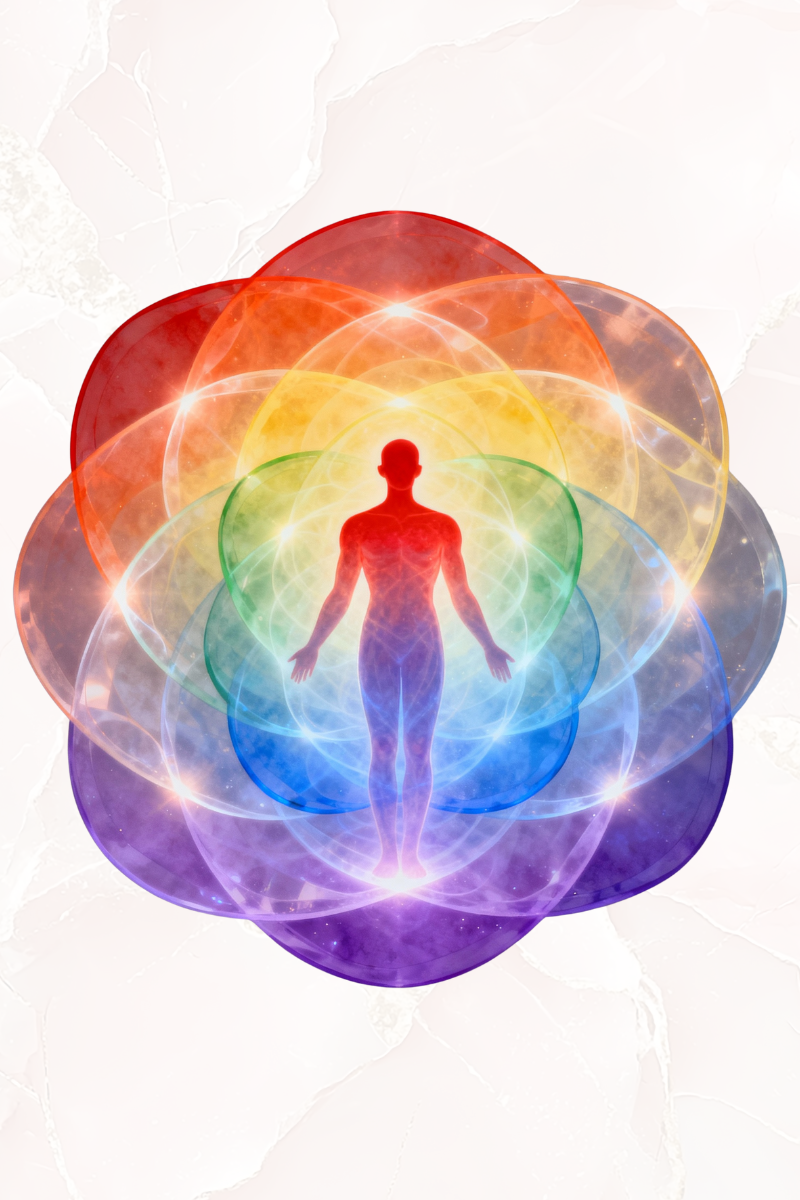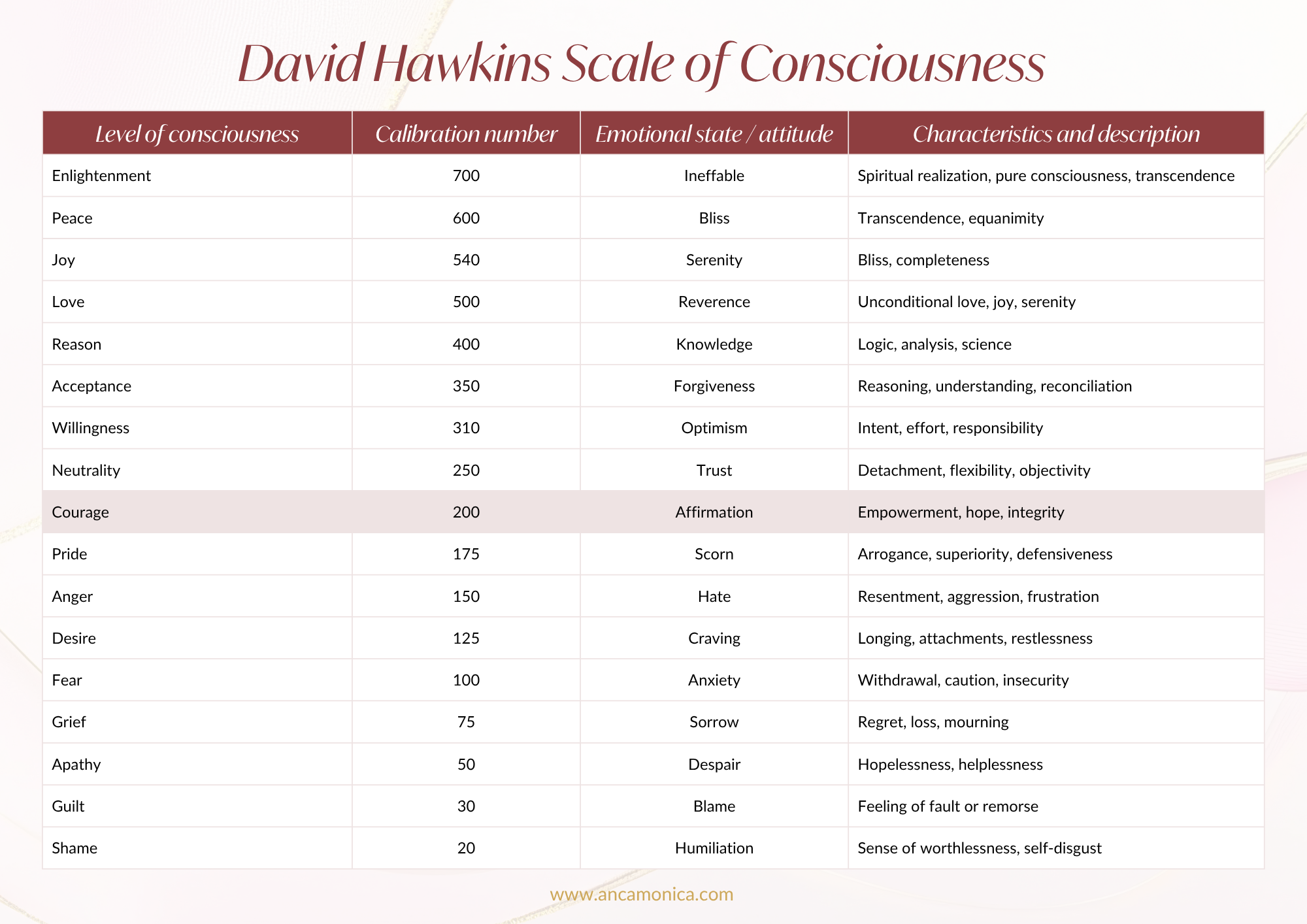
The four bodies of human existence: understanding and elevating consciousness from physical to divine

Written by Anca Monica
Understanding ourselves fully means recognizing the different layers that make up our existence and their place on a scale of consciousness from lower to higher awareness. The four fundamental bodies—the physical, emotional, mental, and divine (spiritual) bodies—can be ordered by David Hawkins’ Scale of Consciousness, which ranges from fear and survival at lower levels to enlightenment at the highest. This article explores each body in this order, integrating Carl Jung’s psychological perspective, spiritual insights, practical ways to connect, and the benefits of being aware.
The physical body
the foundation of existence
Consciousness level: Below 200 on Hawkins’ scale, associated with survival, fear, and pride.
The physical body is our tangible and biological vessel. It grounds us in the material world but can keep us limited if overly identified with its needs and insecurities.
Carl Jung’s view: Jung saw the physical body as more than mere matter — it is the living expression of the psyche and the visible soul. It embodies drives, instincts, and unconscious contents, serving as a crucial part of personal wholeness and psychological health.
How to connect:
-
Practice mindful movement such as yoga, tai chi, or walking meditation.
-
Tune into bodily sensations through breath awareness and body scans.
-
Prioritize self-care, rest, and healthy nutrition to honor the body’s needs.
Benefits of connection:
Connecting with the physical body fosters vitality, presence, and groundedness. It anchors spiritual and psychological work in lived experience, supporting resilience and balance in daily life.
The body of emotions
the bridge of inner truths
Consciousness Llvel: Approximately 100–350, spanning from pain, anger, and fear to courage and acceptance.
The emotional body expresses our inner states and acts as a dynamic intermediary between survival and higher consciousness.
Carl Jung’s view: Jung acknowledged emotions as powerful archetypal energies that influence both psyche and body. Unexpressed or suppressed emotions manifest physically and psychologically until integrated through awareness.
How to connect:
-
Develop emotional intelligence through journaling and reflective practices.
-
Use breathwork or somatic therapies to release trapped emotions.
-
Embrace feelings fully without judgment to foster healing.
Benefits of connection:
Awareness of the emotional body nurtures compassion, emotional resilience, and authenticity. It enables healing past wounds and prevents unconscious emotional patterns from controlling your life.
The body of the mind
the seat of reason and awareness
Consciousness level: Around 400–500+, covering reason, understanding, and love.
The mental body relates to thoughts, perceptions, and beliefs, helping us discern, plan, and make conscious choices.
Carl Jung’s view: For Jung, the mind is the center of consciousness and ego, deeply linked with the body. The ego integrates sensations and feeling-tones, making the mind-body connection essential for individuation and growth.
How to connect:
-
Cultivate mindfulness and meditation to observe mental processes.
-
Practice cognitive discernment to recognize limiting beliefs.
-
Engage in learning, creative thinking, and self-inquiry.
Benefits of connection:
Nurturing the mental body enhances clarity, wisdom, and emotional balance. It empowers conscious decision-making and supports upward movement on the scale of consciousness.
The divine (spiritual) body
The Pinnacle of Consciousness
Consciousness level: Between 500 and 1000+, encompassing love, joy, peace, and enlightenment.
The divine body represents our spiritual essence and connection to universal consciousness.
Carl Jung’s view: Jung linked the divine body to the subtle spiritual aspects of the psyche, archetypes, and symbols of transcendence. It is where individual transformation meets universal unity.
How to connect:
-
Engage in spiritual practices like prayer, meditation, and ritual.
-
Cultivate compassion, gratitude, and unconditional love.
-
Seek experiences of stillness, surrender, and transcendent awareness.
Benefits of connection:
Honoring the divine body cultivates inner peace, spiritual fulfillment, and a deep sense of purpose. It inspires unity with all beings and liberation from ego limitations.
The power of integrative awareness
Aligning your awareness across the physical, emotional, mental, and divine bodies invites wholeness into your life. Each body plays a vital role on the path from survival to enlightenment, offering unique lessons and opportunities for growth. Being conscious of these layers supports healing, balance, and spiritual awakening, unlocking your fullest human potential. The wisdom of Carl Jung together with David Hawkins’ scale offer a compelling framework to understand and nurture each dimension, helping you live with harmony, authenticity, and profound connection.


Related Articles
Related
The five emotional wounds
The concept of the five wounds of the child, introduced by Canadian psychologist Lise Bourbeau, explores how early emotional experiences shape our adult lives. These invisible imprints often influence how we relate to others, how we view ourselves, and how we respond...
Why I decided to share my healing journey
In the spirit of living in harmony, ARMONIA with Anca Monica was born from a simple yet profound realization: nothing in life happens by chance, and every step of our journey carries the potential to guide us toward our true self. As I navigated my own path of...

